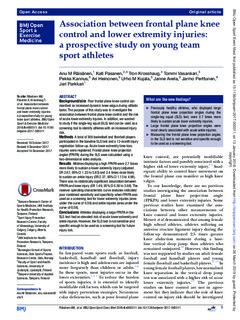| dc.contributor.author | Räisänen, Anu | |
| dc.contributor.author | Pasanen, Kati | |
| dc.contributor.author | Krosshaug, Tron | |
| dc.contributor.author | Vasankari, Tommi | |
| dc.contributor.author | Kannus, Pekka | |
| dc.contributor.author | Heinonen, Ari | |
| dc.contributor.author | Kujala, Urho M | |
| dc.contributor.author | Avela, Janne | |
| dc.contributor.author | Perttunen, Jarmo | |
| dc.contributor.author | Parkkari, Jari | |
| dc.date.accessioned | 2019-05-08T10:54:17Z | |
| dc.date.available | 2019-05-08T10:54:17Z | |
| dc.date.created | 2019-01-21T08:23:33Z | |
| dc.date.issued | 2018 | |
| dc.identifier.citation | BMJ Open Sport & Exercise Medicine. 2018, 4, e000311. | nb_NO |
| dc.identifier.issn | 2055-7647 | |
| dc.identifier.uri | http://hdl.handle.net/11250/2596967 | |
| dc.description | This is an Open Access article distributed in accordance with the Creative Commons Attribution Non Commercial (CC BY-NC 4.0) license, which permits others to distribute, remix, adapt, build upon this work non-commercially, and license their derivative works on different terms, provided the original work is properly cited and the use is non-commercial. See: http://creativecommons.org/licenses/by-nc/4.0/ | nb_NO |
| dc.description.abstract | Background/aim: Poor frontal plane knee control can manifest as increased dynamic knee valgus during athletic tasks. The purpose of this study was to investigate the association between frontal plane knee control and the risk of acute lower extremity injuries. In addition, we wanted to study if the single-leg squat (SLS) test can be used as a screening tool to identify athletes with an increased injury risk. Methods: A total of 306 basketball and floorball players participated in the baseline SLS test and a 12-month injury registration follow-up. Acute lower extremity time-loss injuries were registered. Frontal plane knee projection angles (FPKPA) during the SLS were calculated using a two-dimensional video analysis. Results: Athletes displaying a high FPKPA were 2.7 times more likely to sustain a lower extremity injury (adjusted OR 2.67, 95% CI 1.23 to 5.83) and 2.4 times more likely to sustain an ankle injury (OR 2.37, 95% CI 1.13 to 4.98). There was no statistically significant association between FPKPA and knee injury (OR 1.49, 95% CI 0.56 to 3.98). The receiver operating characteristic curve analyses indicated poor combined sensitivity and specificity when FPKPA was used as a screening test for lower extremity injuries (area under the curve of 0.59) and ankle injuries (area under the curve of 0.58). Conclusions: Athletes displaying a large FPKPA in the SLS test had an elevated risk of acute lower extremity and ankle injuries. However, the SLS test is not sensitive and specific enough to be used as a screening tool for future injury risk. | nb_NO |
| dc.language.iso | eng | nb_NO |
| dc.subject | ankle | nb_NO |
| dc.subject | knee injuries | nb_NO |
| dc.subject | risk factor | nb_NO |
| dc.subject | sporting injuries | nb_NO |
| dc.title | Association between frontal plane knee control and lower extremity injuries: a prospective study on young team sport athletes | nb_NO |
| dc.type | Journal article | nb_NO |
| dc.type | Peer reviewed | nb_NO |
| dc.description.version | publishedVersion | nb_NO |
| dc.rights.holder | © Article author(s) (or their employer(s) unless otherwise stated in the text of the article) 2018. All rights reserved. No commercial use is permitted unless otherwise expressly granted. | nb_NO |
| dc.source.pagenumber | 10 | nb_NO |
| dc.source.volume | 4 | nb_NO |
| dc.source.journal | BMJ Open Sport & Exercise Medicine | nb_NO |
| dc.identifier.doi | 10.1136/bmjsem-2017-000311 | |
| dc.identifier.cristin | 1661851 | |
| dc.description.localcode | Seksjon for idrettsmedisinske fag / Department of Sport Medicine | nb_NO |
| cristin.unitcode | 150,34,0,0 | |
| cristin.unitname | Seksjon for idrettsmedisinske fag | |
| cristin.ispublished | true | |
| cristin.fulltext | original | |
| cristin.qualitycode | 1 | |
